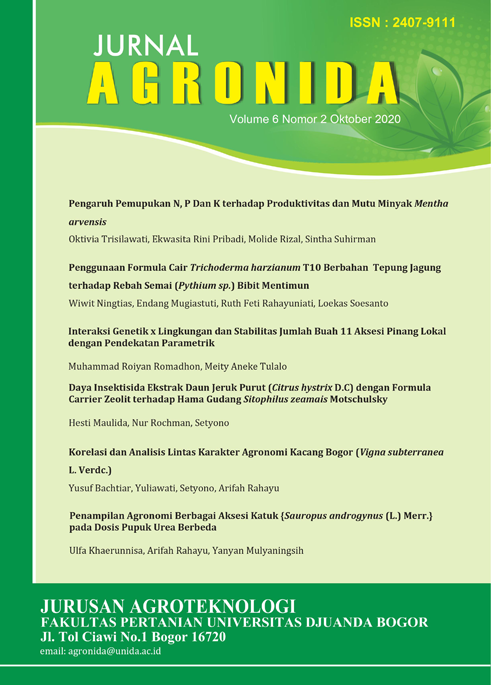Main Article Content
Abstract
This study was aimed at assessing the efficacy of several multiple liquid biofertilizers found in the market on the growth and production of sweet corn. A factorial completely randomized design was used. The first factor was the type of multiple liquid biofertilizers (PHMC) consisting of three levels, namely PHMC 1, PHMC 2, and PHMC 3. The second factor was synthetic fertilizer rates consisting of five levels, namely 0, 25, 50, 75, and 100% of recommended rate (R). Results showed that the application of PHMC 3 combined with synthetic fertilizer treatments (05 R and 25% R) significantly increased stem diameter (8 WAP). Plants treated with PHMC 3 application were found to have significantly higher number of leaves than those treated with PHMC 2 application at 6 WAP. Plant height, number of leaves, and weight, length, and circumference of main cob of plants treated with 50%R synthetic fertilizer were higher than those of plants treated with 0%R and 25%R synthetic fertilizer. Meanwhile, plants treated with 75%R synthetic fertilizer were found to have better values for girth, leave width, flowering time, harvesting time, number of cobs, dry weight of shoots and roots, grain total soluble solids (TSS) content, and cobs weight than those of plants treated with 0, 25, and 50%R synthetic fertilizer.
Key words: sweet corn, multiple liquid biofertilizers, TSS, synthetic fertilizer.
Article Details
References
-
Andriawan I. 2010. Efektivitas pupuk hayati terhadap pertumbuhan dan hasil padi sawah. [skripsi]. Bogor : Institut Pertanian Bogor. Effendi S. 1985. Bercocok Tanam Jagung. Jakarta : Yasaguna. Gardner FP, Peace RB, Michell RL. 1991. Fisiologi Tanaman Budidaya. Terjemahan Herawati Susilo.Jakarta: UI Pres. Goenadi DH. 1995. Mikroba pelarut hara dan pemantap agregat dari beberapa tanah tropika basah. Menara Perkebunan. 62: 60-66. Hamim. 2008. Pengaruh pupuk hayati terhadap pola serapan hara, ketahanan penyakit, produksi dan kualitas hasil beberapa komoditas tanaman pangan dan sayuran unggulan. Laporan Penelitian KK3PT. Institut Pertanian Bogor. Bogor. Hardjowigeno S. 2007. Ilmu Tanah. Jakarta: CV. Akademika Pressindo. Robi’in. 2009. Teknik pengujian daya hasil jagung bersari bebas (komposit) di lokasi Prima Tani Kabupaten Probolinggo, Jawa Timur. Buletin Teknik Pertanian 14(2):2009:45–49. Simanungkalit RDM. 2001. Aplikasi pupuk hayati dan pupuk kimia: suatu pendekatan terpadu. Buletin Agrobiol. 42(2): 56-61.
Sinaga J, Rosmimi. 2010. Pertumbuhan dan produksi jagung manis (Zea mays L. saccharata) pada tanah gambut yang diaplikasikan amelioran dregs dan fosfat alam. Sagu. 9(2): 20 – 27. Vessey JK. 2003. Plant growth promoting rhizobacteria as biofertilizer. Plant Soil. 255: 571 - 586.
Wibowo ST. 2008. Kandungan Hormon IAA, Serapan Hara, dan Pertumbuhan Beberapa Tanaman Budidaya Sebagai Respon terhadap Aplikasi Pupuk Biologi [Tesis]. Bogor: Institut Pertanian Bogor.
References
Sinaga J, Rosmimi. 2010. Pertumbuhan dan produksi jagung manis (Zea mays L. saccharata) pada tanah gambut yang diaplikasikan amelioran dregs dan fosfat alam. Sagu. 9(2): 20 – 27. Vessey JK. 2003. Plant growth promoting rhizobacteria as biofertilizer. Plant Soil. 255: 571 - 586.
Wibowo ST. 2008. Kandungan Hormon IAA, Serapan Hara, dan Pertumbuhan Beberapa Tanaman Budidaya Sebagai Respon terhadap Aplikasi Pupuk Biologi [Tesis]. Bogor: Institut Pertanian Bogor.
